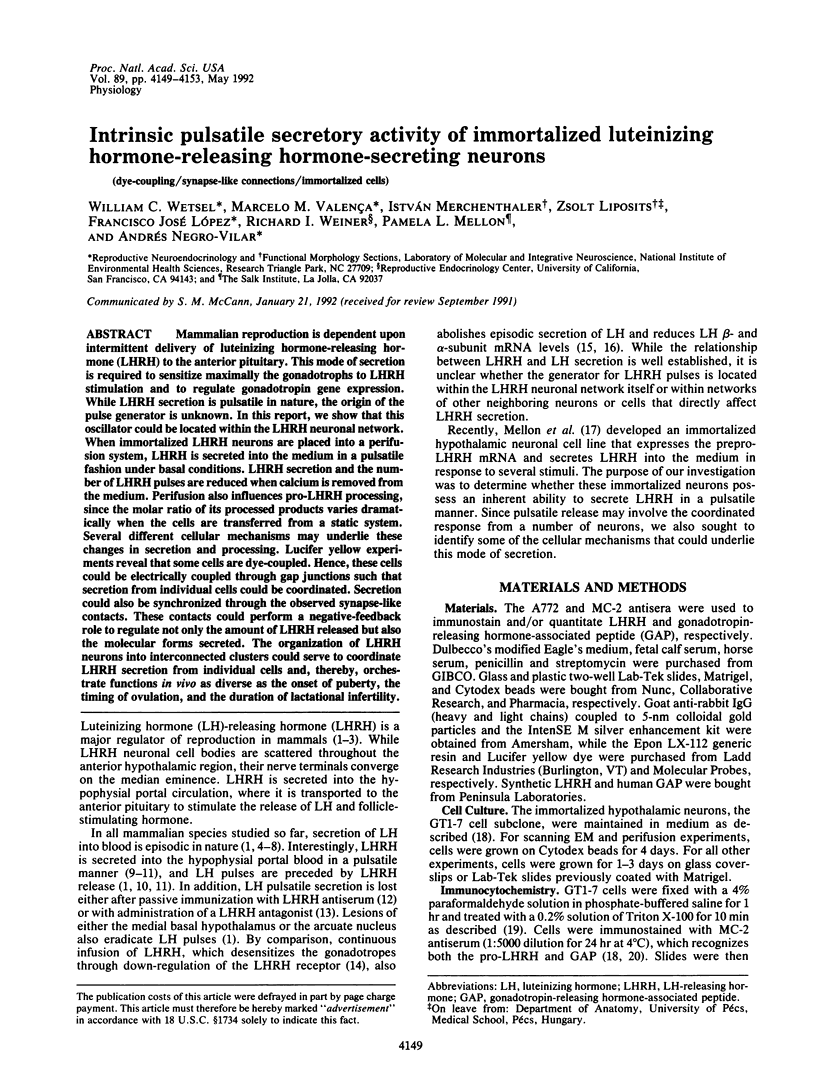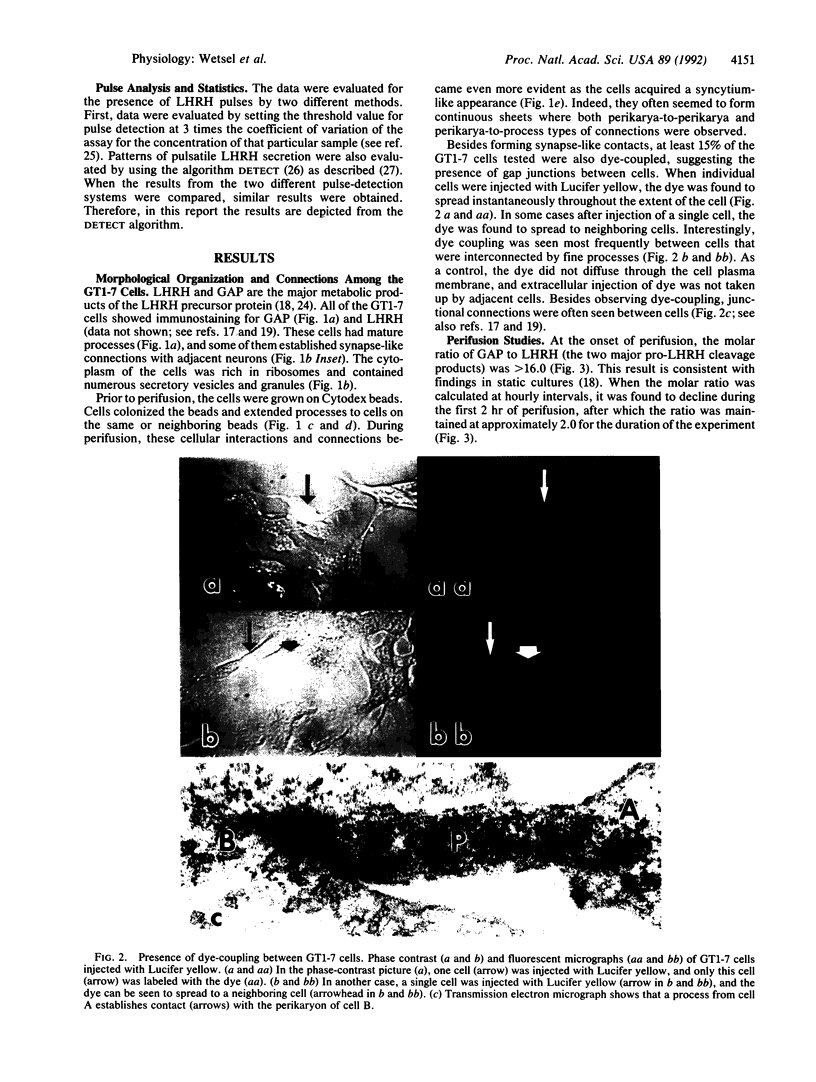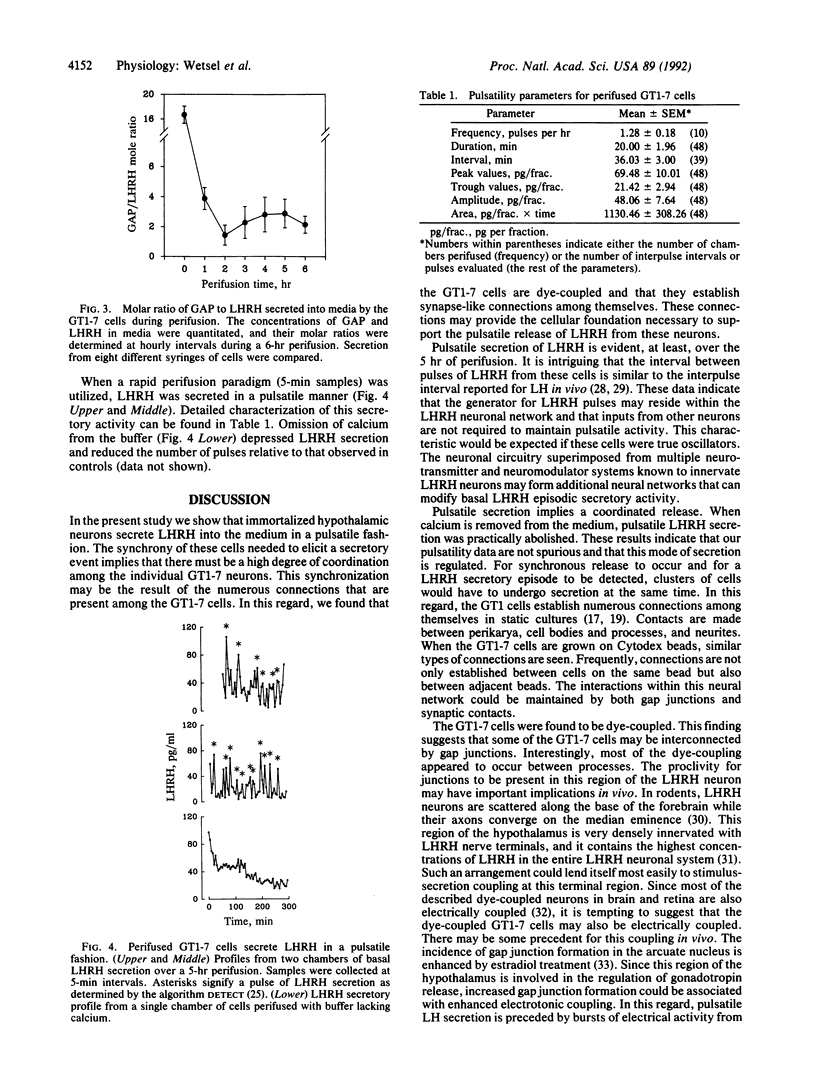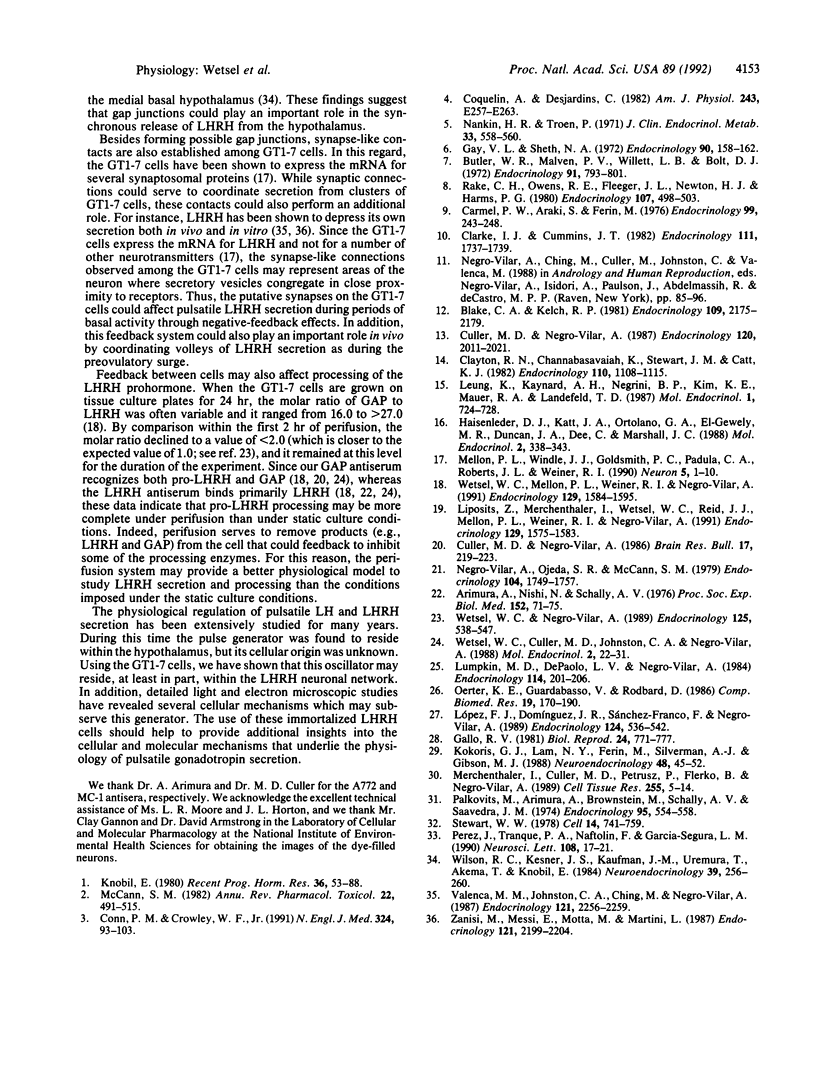Abstract
Mammalian reproduction is dependent upon intermittent delivery of luteinizing hormone-releasing hormone (LHRH) to the anterior pituitary. This mode of secretion is required to sensitize maximally the gonadotrophs to LHRH stimulation and to regulate gonadotropin gene expression. While LHRH secretion is pulsatile in nature, the origin of the pulse generator is unknown. In this report, we show that this oscillator could be located within the LHRH neuronal network. When immortalized LHRH neurons are placed into a perifusion system, LHRH is secreted into the medium in a pulsatile fashion under basal conditions. LHRH secretion and the number of LHRH pulses are reduced when calcium is removed from the medium. Perifusion also influences pro-LHRH processing, since the molar ratio of its processed products varies dramatically when the cells are transferred from a static system. Several different cellular mechanisms may underlie these changes in secretion and processing. Lucifer yellow experiments reveal that some cells are dye-coupled. Hence, these cells could be electrically coupled through gap junctions such that secretion from individual cells could be coordinated. Secretion could also be synchronized through the observed synapse-like contacts. These contacts could perform a negative-feedback role to regulate not only the amount of LHRH released but also the molecular forms secreted. The organization of LHRH neurons into interconnected clusters could serve to coordinate LHRH secretion from individual cells and, thereby, orchestrate functions in vivo as diverse as the onset of puberty, the timing of ovulation, and the duration of lactational infertility.
Full text
PDF




Images in this article
Selected References
These references are in PubMed. This may not be the complete list of references from this article.
- Arimura A., Nishi N., Schally A. V. Delayed implantation caused by administration of sheep immunogamma globulin against LHRH in the rat. Proc Soc Exp Biol Med. 1976 May;152(1):71–75. doi: 10.3181/00379727-152-39331. [DOI] [PubMed] [Google Scholar]
- Blake C. A., Kelch R. P. Administration of antiluteinizing hormone-releasing hormone serum to rats: effects on periovulatory secretion of luteinizing hormone and follicle-stimulating hormone. Endocrinology. 1981 Dec;109(6):2175–2179. doi: 10.1210/endo-109-6-2175. [DOI] [PubMed] [Google Scholar]
- Butler W. R., Malven P. V., Willett L. B., Bolt D. J. Patterns of pituitary release and cranial output of LH and prolactin in ovariectomized ewes. Endocrinology. 1972 Sep;91(3):793–801. doi: 10.1210/endo-91-3-793. [DOI] [PubMed] [Google Scholar]
- Carmel P. W., Araki S., Ferin M. Pituitary stalk portal blood collection in rhesus monkeys: evidence for pulsatile release of gonadotropin-releasing hormone (GnRH). Endocrinology. 1976 Jul;99(1):243–248. doi: 10.1210/endo-99-1-243. [DOI] [PubMed] [Google Scholar]
- Clarke I. J., Cummins J. T. The temporal relationship between gonadotropin releasing hormone (GnRH) and luteinizing hormone (LH) secretion in ovariectomized ewes. Endocrinology. 1982 Nov;111(5):1737–1739. doi: 10.1210/endo-111-5-1737. [DOI] [PubMed] [Google Scholar]
- Clayton R. N., Channabasavaiah K., Stewart J. M., Catt K. J. Hypothalamic regulation of pituitary gonadotropin-releasing hormone receptors: effects of hypothalamic lesions and a gonadotropin-releasing hormone antagonist. Endocrinology. 1982 Apr;110(4):1108–1115. doi: 10.1210/endo-110-4-1108. [DOI] [PubMed] [Google Scholar]
- Conn P. M., Crowley W. F., Jr Gonadotropin-releasing hormone and its analogues. N Engl J Med. 1991 Jan 10;324(2):93–103. doi: 10.1056/NEJM199101103240205. [DOI] [PubMed] [Google Scholar]
- Coquelin A., Desjardins C. Luteinizing hormone and testosterone secretion in young and old male mice. Am J Physiol. 1982 Sep;243(3):E257–E263. doi: 10.1152/ajpendo.1982.243.3.E257. [DOI] [PubMed] [Google Scholar]
- Culler M. D., Negro-Vilar A. Development of specific antisera and a radioimmunoassay procedure for the gonadotropin-releasing hormone associated peptide (GAP) of the LHRH prohormone. Brain Res Bull. 1986 Aug;17(2):219–223. doi: 10.1016/0361-9230(86)90118-8. [DOI] [PubMed] [Google Scholar]
- Culler M. D., Negro-Vilar A. Pulsatile follicle-stimulating hormone secretion is independent of luteinizing hormone-releasing hormone (LHRH): pulsatile replacement of LHRH bioactivity in LHRH-immunoneutralized rats. Endocrinology. 1987 May;120(5):2011–2021. doi: 10.1210/endo-120-5-2011. [DOI] [PubMed] [Google Scholar]
- Gallo R. V. Pulsatile LH release during periods of low level LH secretion in the rat estrous cycle. Biol Reprod. 1981 May;24(4):771–777. doi: 10.1095/biolreprod24.4.771. [DOI] [PubMed] [Google Scholar]
- Gay V. L., Sheth N. A. Evidence for a periodic release of LH in castrated male and female rats. Endocrinology. 1972 Jan;90(1):158–162. doi: 10.1210/endo-90-1-158. [DOI] [PubMed] [Google Scholar]
- Haisenleder D. J., Katt J. A., Ortolano G. A., el-Gewely M. R., Duncan J. A., Dee C., Marshall J. C. Influence of gonadotropin-releasing hormone pulse amplitude, frequency, and treatment duration on the regulation of luteinizing hormone (LH) subunit messenger ribonucleic acids and LH secretion. Mol Endocrinol. 1988 Apr;2(4):338–343. doi: 10.1210/mend-2-4-338. [DOI] [PubMed] [Google Scholar]
- Knobil E. The neuroendocrine control of the menstrual cycle. Recent Prog Horm Res. 1980;36:53–88. doi: 10.1016/b978-0-12-571136-4.50008-5. [DOI] [PubMed] [Google Scholar]
- Kokoris G. J., Lam N. Y., Ferin M., Silverman A. J., Gibson M. J. Transplanted gonadotropin-releasing hormone neurons promote pulsatile luteinizing hormone secretion in congenitally hypogonadal (hpg) male mice. Neuroendocrinology. 1988 Jul;48(1):45–52. doi: 10.1159/000124988. [DOI] [PubMed] [Google Scholar]
- Leung K., Kaynard A. H., Negrini B. P., Kim K. E., Maurer R. A., Landefeld T. D. Differential regulation of gonadotropin subunit messenger ribonucleic acids by gonadotropin-releasing hormone pulse frequency in ewes. Mol Endocrinol. 1987 Oct;1(10):724–728. doi: 10.1210/mend-1-10-724. [DOI] [PubMed] [Google Scholar]
- Liposits Z., Merchenthaler I., Wetsel W. C., Reid J. J., Mellon P. L., Weiner R. I., Negro-Vilar A. Morphological characterization of immortalized hypothalamic neurons synthesizing luteinizing hormone-releasing hormone. Endocrinology. 1991 Sep;129(3):1575–1583. doi: 10.1210/endo-129-3-1575. [DOI] [PubMed] [Google Scholar]
- Lumpkin M. D., DePaolo L. V., Negro-Vilar A. Pulsatile release of follicle-stimulating hormone in ovariectomized rats is inhibited by porcine follicular fluid (inhibin). Endocrinology. 1984 Jan;114(1):201–206. doi: 10.1210/endo-114-1-201. [DOI] [PubMed] [Google Scholar]
- López F. J., Dominguez J. R., Sánchez-Criado J. E., Negro-Vilar A. Distinct pulsatile prolactin secretory patterns during the estrous cycle: possible encoding for diverse physiological responses. Endocrinology. 1989 Jan;124(1):536–542. doi: 10.1210/endo-124-1-536. [DOI] [PubMed] [Google Scholar]
- McCann S. M. Physiology and pharmacology of LHRH and somatostatin. Annu Rev Pharmacol Toxicol. 1982;22:491–515. doi: 10.1146/annurev.pa.22.040182.002423. [DOI] [PubMed] [Google Scholar]
- Mellon P. L., Windle J. J., Goldsmith P. C., Padula C. A., Roberts J. L., Weiner R. I. Immortalization of hypothalamic GnRH neurons by genetically targeted tumorigenesis. Neuron. 1990 Jul;5(1):1–10. doi: 10.1016/0896-6273(90)90028-e. [DOI] [PubMed] [Google Scholar]
- Merchenthaler I., Culler M. D., Petrusz P., Flerkó B., Negro-Vilar A. Immunocytochemical localization of the gonadotropin-releasing hormone-associated peptide portion of the LHRH precursor in the hypothalamus and extrahypothalamic regions of the rat central nervous system. Cell Tissue Res. 1989 Jan;255(1):5–14. doi: 10.1007/BF00229060. [DOI] [PubMed] [Google Scholar]
- Nankin H. R., Troen P. Repetitive luteinizing hormone elevations in serum of normal men. J Clin Endocrinol Metab. 1971 Sep;33(3):558–560. doi: 10.1210/jcem-33-3-558. [DOI] [PubMed] [Google Scholar]
- Negro-Vilar A., Ojeda S. R., McCann S. M. Catecholaminergic modulation of luteinizing hormone-releasing hormone release by median eminence terminals in vitro. Endocrinology. 1979 Jun;104(6):1749–1757. doi: 10.1210/endo-104-6-1749. [DOI] [PubMed] [Google Scholar]
- Oerter K. E., Guardabasso V., Rodbard D. Detection and characterization of peaks and estimation of instantaneous secretory rate for episodic pulsatile hormone secretion. Comput Biomed Res. 1986 Apr;19(2):170–191. doi: 10.1016/0010-4809(86)90014-5. [DOI] [PubMed] [Google Scholar]
- Palkovits M., Arimura A., Brownstein M., Schally A. V., Saavedra J. M. Luteinizing hormone-releasing hormone (LH-RH) content of the hypothalamic nuclei in rat. Endocrinology. 1974 Aug;95(2):554–558. doi: 10.1210/endo-95-2-554. [DOI] [PubMed] [Google Scholar]
- Perez J., Tranque P. A., Naftolin F., Garcia-Segura L. M. Gap junctions in the hypothalamic arcuate neurons of ovariectomized and estradiol-treated rats. Neurosci Lett. 1990 Jan 1;108(1-2):17–21. doi: 10.1016/0304-3940(90)90699-a. [DOI] [PubMed] [Google Scholar]
- Rahe C. H., Owens R. E., Fleeger J. L., Newton H. J., Harms P. G. Pattern of plasma luteinizing hormone in the cyclic cow: dependence upon the period of the cycle. Endocrinology. 1980 Aug;107(2):498–503. doi: 10.1210/endo-107-2-498. [DOI] [PubMed] [Google Scholar]
- Stewart W. W. Functional connections between cells as revealed by dye-coupling with a highly fluorescent naphthalimide tracer. Cell. 1978 Jul;14(3):741–759. doi: 10.1016/0092-8674(78)90256-8. [DOI] [PubMed] [Google Scholar]
- Valença M. M., Johnston C. A., Ching M., Negro-Vilar A. Evidence for a negative ultrashort loop feedback mechanism operating on the luteinizing hormone-releasing hormone neuronal system. Endocrinology. 1987 Dec;121(6):2256–2259. doi: 10.1210/endo-121-6-2256. [DOI] [PubMed] [Google Scholar]
- Wetsel W. C., Culler M. D., Johnston C. A., Negro-Vilar A. Processing of the luteinizing hormone-releasing hormone precursor in the preoptic area and hypothalamus of the rat. Mol Endocrinol. 1988 Jan;2(1):22–31. doi: 10.1210/mend-2-1-22. [DOI] [PubMed] [Google Scholar]
- Wetsel W. C., Mellon P. L., Weiner R. I., Negro-Vilar A. Metabolism of pro-luteinizing hormone-releasing hormone in immortalized hypothalamic neurons. Endocrinology. 1991 Sep;129(3):1584–1595. doi: 10.1210/endo-129-3-1584. [DOI] [PubMed] [Google Scholar]
- Wetsel W. C., Negro-Vilar A. Testosterone selectively influences protein kinase-C-coupled secretion of proluteinizing hormone-releasing hormone-derived peptides. Endocrinology. 1989 Jul;125(1):538–547. doi: 10.1210/endo-125-1-538. [DOI] [PubMed] [Google Scholar]
- Wilson R. C., Kesner J. S., Kaufman J. M., Uemura T., Akema T., Knobil E. Central electrophysiologic correlates of pulsatile luteinizing hormone secretion in the rhesus monkey. Neuroendocrinology. 1984 Sep;39(3):256–260. doi: 10.1159/000123988. [DOI] [PubMed] [Google Scholar]
- Zanisi M., Messi E., Motta M., Martini L. Ultrashort feedback control of luteinizing hormone-releasing hormone secretion in vitro. Endocrinology. 1987 Dec;121(6):2199–2204. doi: 10.1210/endo-121-6-2199. [DOI] [PubMed] [Google Scholar]




